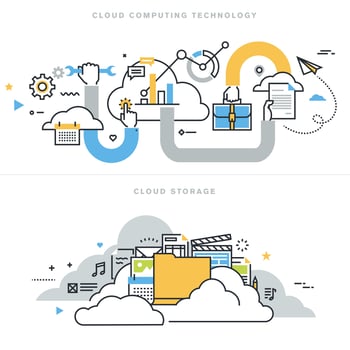Software defined storage (SDS) is a cost-effective way for companies to store their data in a safe cloud environment while freeing up space traditionally taken up by physical hardware. It can also provide a stronger level of data protection since cloud service providers (although their security policies vary) have a responsibility to care for customer data, per your service agreement. How can you determine if this fits into your organization’s budget? First, let’s dive into the circumstances that created a need for SDS
A Brief History of Software Defined Storage
Before virtualization, enterprises relied on direct attached storage through intelligence driven hardware. Unfortunately, using a hardware solution to create enterprise-level redundancy is expensive and usually involves proprietary or custom storage systems with higher up-front acquisition and on-going operational costs. Because of this, many businesses became priced out of the market. Besides the exorbitant cost factor, physical hardware is also rigid and inflexible. All this has paved the way for software defined storage.
SDS leverages the intelligence, flexibility and scalability of software. Rather than employing a specialized proprietary hardware design, SDS uses commodity enterprise storage hardware that is managed by intelligent software. Software defined storage can be implemented on any x86 server and any server-attached storage device. This allows it to offer an incredible flexibility of choice for IT managers and avoids the pesky problem of vendor lock-in. It also offers substantial up-front cost savings while providing the intelligence and flexibility of software, in addition to the redundancy that enterprises today demand.
Storage Placement and Automated Tiering
Storage isn’t just measured by capacity; instead try to think of your storage infrastructure as a virtual city. You have high-rent districts where corporate centers are located and low-rent districts where warehouse districts are congregated. You wouldn’t locate a self-storage unit complex on ocean front property or in a corporate center of a major metropolis. The same is true with placing data for storage. There is high-value/highly-utilized data that justifies high-performance expensive storage disks, and you also have archived data generated to fulfill government regulations and justifies a minimum level of storage performance.
SDS is about allocating true Automated Storage Tiering for enterprises and has created a natural and timely partnership with flash storage. This is why it’s beneficial to fragment your data infrastructure into multiple tiers. Organizations create and demand all types of data, and each type has different demands from your storage infrastructure. One type of data may require incredibly high performance no matter the cost. Other data only requires modest performance at a reasonable cost, while long-term retention data can settle for minimum levels of performance.
How to Determine the True Cost of Your Data
IT managers planning for enterprise storage capacity and cost must consider the following five components, according to a whitepaper from the University of Alabama at Birmingham by Amit Kumar Dutta and Ragib Hasa:
- The Initial Cost: This includes all the costs related to infrastructure setup, as well as the required supporting hardware such as iSCSI or fiber switches. The cost for the necessary network switches and routers must be factored in as well. A cost per byte can be calculated with this formula: Initial Cost Per Byte = Initial Cost for N disks + Infrastructure/Total bytes S.
- Available Floor and Rack Space: Does your organization have the physical space to house on-premise information?
- Energy and Cooling Costs: These utility requirements are a major part of supporting a data center.
- Service and Support Costs: This includes the cost of the average time spent by your internal staff to support the data infrastructure as well as support and maintenance contracts. Training costs associated with advanced SAN array storage devices should also be included.
All of these considerations can be calculated to obtain a cost per byte. Once these individual costs are tabulated, the total cost per byte can be tabulated for the entirety of your enterprise.
Other Potential Data Center Costs
There are other potential costs of your data, the first being vendor lock-in. Once an organization substantially invests in infrastructure and training, there is a definite cost for switching vendors and technologies, so be sure you want to work with a company before signing on. There is also an additional cost that is rarely factored in: opportunity cost. Businesses must always factor this in when assessing the true financial cost of a decision.
Many times, IT managers find themselves making decisions regarding the storage of data based on their available storage, especially when they depend on expensive, redundant external arrays. Those who find themselves nearing full storage capacity will consider making compromises. These decisions can have far reaching implications down the road for the organization; we strongly encourage meeting with an expert to help you make the right choice.
Next steps
Software defined storage has helped countless companies free up physical space and improve data security. For a more in-depth review of SDS, take a moment to read our white paper, Managing your Data with Software Defined Storage.










